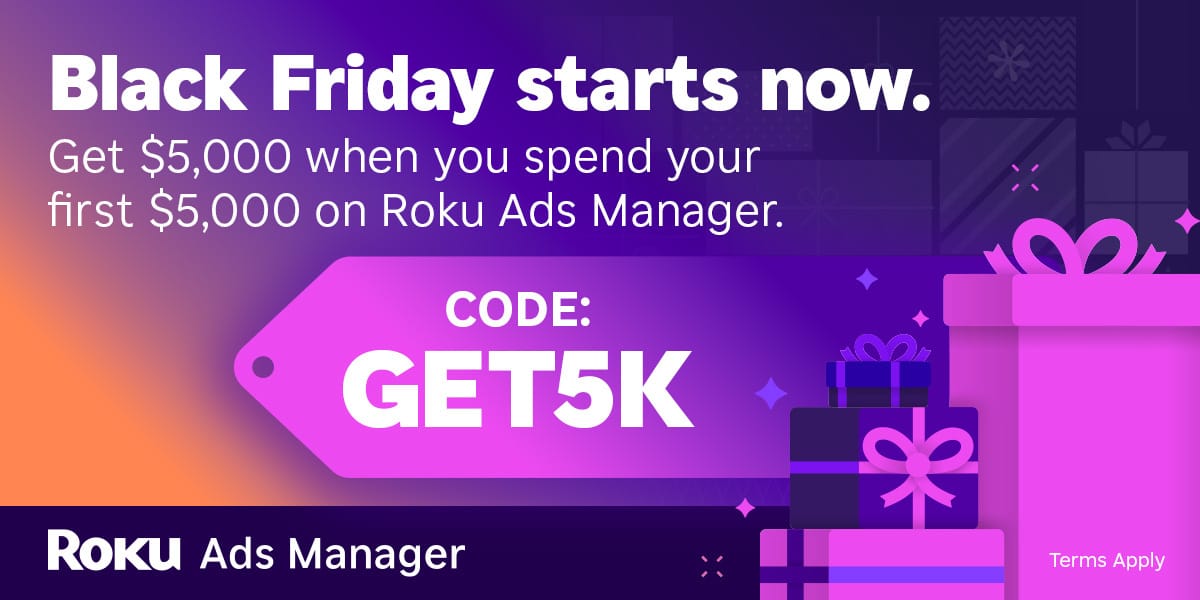Wise Words:
“There are two only motivators: pain and pleasure.”
This email gets into the 3 steps to leverage the most powerful motivator - pain so you can get more people to buy.
Find your customers on Roku this Black Friday
As with any digital ad campaign, the important thing is to reach streaming audiences who will convert. To that end, Roku’s self-service Ads Manager stands ready with powerful segmentation and targeting options. After all, you know your customers, and we know our streaming audience.
Worried it’s too late to spin up new Black Friday creative? With Roku Ads Manager, you can easily import and augment existing creative assets from your social channels. We also have AI-assisted upscaling, so every ad is primed for CTV.
Once you’ve done this, then you can easily set up A/B tests to flight different creative variants and Black Friday offers. If you’re a Shopify brand, you can even run shoppable ads directly on-screen so viewers can purchase with just a click of their Roku remote.
Bonus: we’re gifting you $5K in ad credits when you spend your first $5K on Roku Ads Manager. Just sign up and use code GET5K. Terms apply.
#1 Sell painkillers not vitamins
Your business should be a painkiller not a vitamin. It needs to solve an immediate problem that gets people to buy.
When you have a massive headache, you buy a painkiller not a vitamin. Because painkillers are needed to reduce the pain and get customers to take action.
The components of a painkiller
Solves an urgent, costly, or emotionally painful problem
Brings immediate relief to a customer problem
Drives buyer to take action now
People buy painkillers that solve their problems. They aren’t interested in vitamins that are just nice to have.
(Shoutout to Katelyn Bourgoin who taught me this lesson)
Curated Example:

QuickBooks solves the problem of accurate bookkeeping that is easy and doesn’t take long.
Their business isn’t a software to help with finances. They are a pain relief tool for small businesses to manage their invoices and finances.
#2 Uncover your customer’s deep pains
You need to understand your customers their exact pain points and triggers that get them to buy.
Here’s how you do it:
Review mining
Go look at product reviews/testimonials/comments within your niche. Amazon, Reddit, and Trustpilot are all good places to get reviews
Look for specific pains, triggers, and emotional language. Especially try to find before stories where you hear about what life was like before the problem was solved.
Customer Interviews
Interview 10 of your highest-value buyers
Ask for what triggered the purchase
Record and copy their exact language
Surveys
Ask your customers 3 questions
How often do you experience X problem (1-5)
How painful is the problem when it happens (1-5)
If you could wave a wand and make it go away, how much would you pay?
The highest frequency and highest pain problems are what you need to solve.
Pro Tip: Understand the trigger of what caused the viewer to buy. This is the pain they faced before you solved their problem.
Example of a buying trigger: “I lost hours of time managing leads across spreadsheets”
Now, target that trigger and emphasize how you will solve that problem in your website and ads.
“This is the all-in solution to manage leads, so you don’t have to waste hours scrambling across spreadsheets”
#3 Turn your business into a painkiller
Use the specific pains you found when doing your research. Then turn your business into a painkiller.
The painkiller framework
Use this in your website, ads, and emails to get customers to feel the pain and buy.
Pain: state the urgent and costly pain
Trigger moment: use their buying trigger and emphasize their pain
Emphasize the cost of doing nothing
Relief: tell your promise and solution to problem
Why: show user-generated-content and social proof
Curated Example:

Calendly targets the pain points of a confusing scheduling.
Here is Calendly’s painkiller framework:
Pain: wasted time from back-and-forth scheduling
Trigger moment: when a client asks, “what time works for you?” and a long email chain of scheduling begins.
Cost of doing nothing: wasted time, frustration, and less efficient meetings
Relief: making scheduling simple and without back-and-forth
Why: trust logos of famous companies and testimonials of easier scheduling
Until next Saturday,
Warren
PS - I made a list of my favorite business books that contain invaluable on marketing, startups, and business strategy.
If you want it, share this newsletter with two friends to get access.


